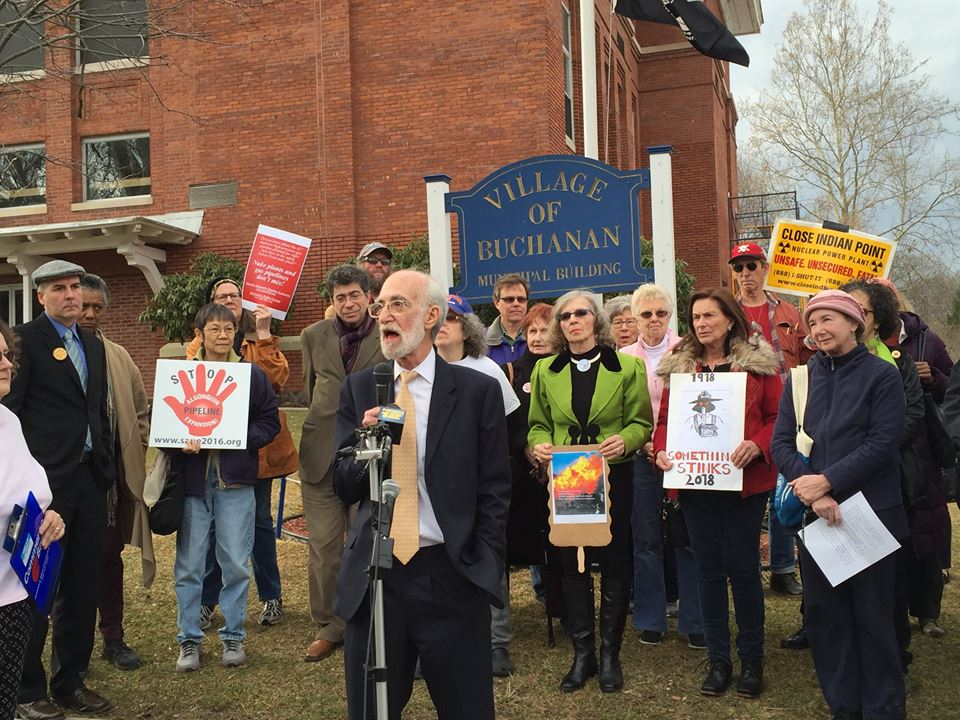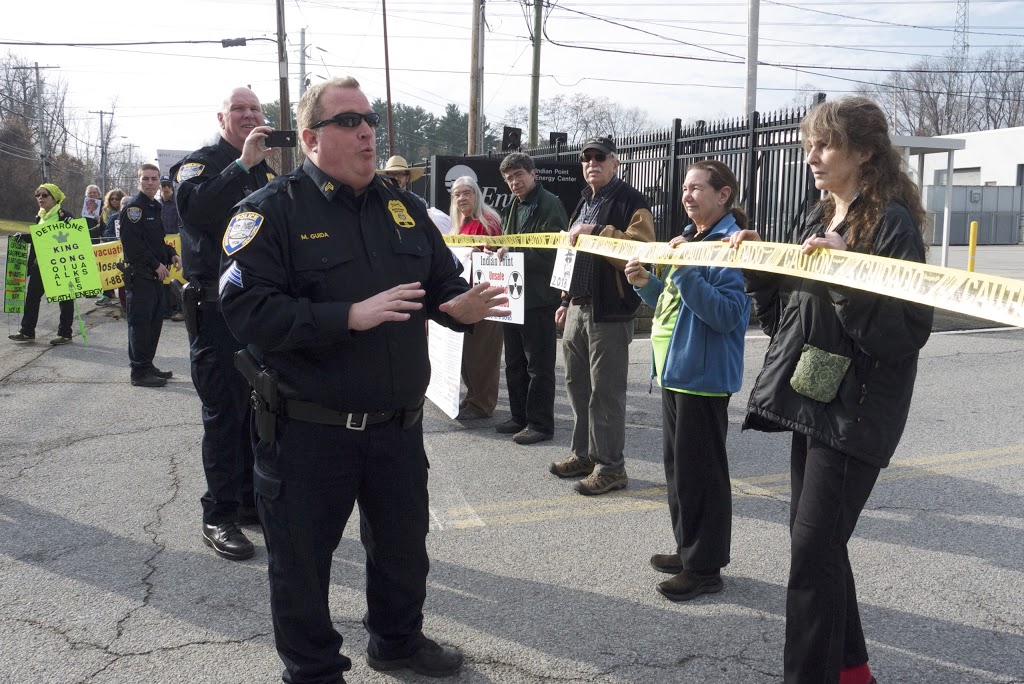
BY JK CANEPA | At midnight on Dec. 12 of last year, the final license for Indian Point Energy Center’s reactors expired. To mark the event, about 50 people walked up the road to the entrance of the nuclear power plant in Buchanan, N.Y., a small Westchester County municipality on the edge of Peekskill. Among the assemblage were several elderly Franciscan nuns, a frail Buddhist nun who had stood in silent protest when the plant was built more than 40 years ago, people of the (real) first world accompanying us with drums, a professor, a retired minister and others who traveled from Connecticut, New Jersey, and New York City, and those who lived close to the aging, leaking, deteriorating plant, residents of Westchester, Putnam, and Rockland Counties.
As we continued uphill, we stepped over chalk marks that said “Algonquin Pipeline.” Then I knew we were close — 105 feet from the safety equipment for the plant, in fact — and I pointed this out to the sisters. Moments later, we were in front of Indian Point and its giant domes.
We stretched yellow caution tape to block workers’ access as the drummers marked time. When told to disperse, 11 of us stood our ground, including three from the city: Bruce Rosen, Merle McEldowney and me.
One of the sweet nuns waved goodbye as we entered the paddy wagon. We were arrested and charged with disorderly conduct. (In fact, I think we were quite orderly and well-behaved, and wonder if the police know what disorderliness can look like!) In any case, we forked over our ID’s for inspection and then spent an hour in the precinct, handcuffs removed, in a carpeted back room with a Toys for Tots barrel, several chairs, restrooms — a pretty low-key bust, all in all. Then those of us not from the area each paid $100 bail and we all went to our respective homes.
On Tues., March 8, we had our day at the courthouse, both outside in front of reporters and inside before the judge. Of course, the anti-nuclear voices were there (Indian Point Safe Energy Coalition, Nuclear Information and Resource Service, Stony Point Convergence, Shut Down Indian Point Now). But there were also allies from all over: anti-fracking and anti-pipeline groups (Stop the Algonquin Pipeline, United for Action), clean water advocates (Riverkeeper, Hudson River Sloop Clearwater and New York City Friends of Clearwater, Catskill Mountainkeeper), groups part of the large greens (Sierra Club Lower Hudson) and small (Westchester People’s Action Coalition, Grassroots Environmental, New York City Safe Energy Campaign) and more.
A speaker from Fukushima sent a message of support and a reminder that the fifth anniversary of that tragedy was days away. We talked about the safety exemptions that Entergy received for the shoddy conditions in the plant, the spills and fires and numerous shutdowns. We brought out our “Bird Poop” banner to let the world know that one big bird streaming one enormous dropping onto the company’s wiring actually had caused Indian Point to close down just days after our arrest.
We exposed Entergy’s lie that they provide Westchester and New York City with 25 to 30 percent of our energy and explained that we don’t need one watt from this plant, since we’ve already replaced it with efficiency and solar, to the point that we’re covered even for peak load.
We asked what would happen to the 20 million people in the peak danger zone, where would they go in the event of an emergency? What fantasies about evacuation does the government have? We railed against the federal Nuclear Regulatory Commission and its revolving-door policy for industry hacks who come into government, approve projects, and then return to choice jobs in the corporate world.
And we talked about Spectra Energy’s 42-inch Algonquin Incremental Market (AIM) Pipeline clearcutting its way through private property grabbed by eminent domain and heading to within just 100 feet of the plant’s critical infrastructure. We made it clear that Spectra’s claim of a three-minute response to any failure of the pipeline was clearly impossible, because the shutdown valves are miles apart and the company operates them from computers in Texas. And the company has an abysmal safety record.
We quoted industry experts about the 400-foot blast radius in every direction when a pipeline ruptures, opening up like a zipper moving at very high speed, carrying flammable gas at pressures of about 900 pounds per square inch. We pointed out the earthquake zones beneath our feet where we stood on the grounds of the courthouse.

We explained that uranium mining and the fossil fuels that a nuclear plant needs for its operations aren’t clean energy, that polluting the water and killing the fish isn’t sustainable energy, that radioactive leakage of tritium and who knows what else into the groundwater at 400 to 800 times the maximum safe level certainly isn’t a part of safe energy for the people and animals of the region.
Finally it was time to go inside — court was about to begin. Our lawyer, Martin Stolar, who is also representing the Montrose 9, who blocked movement of machinery on the AIM pipeline, pled guilty on behalf of the entire group. (This other case may be a groundbreaking one, with the “necessity defense” in play.)
We stood proudly and repeated to the judge, one at a time, “Guilty.” I sure didn’t feel guilty. I don’t think any of the others did either. But a not-guilty plea might have resulted in an A.C.D., adjournment upon contemplation of dismissal, meaning it’s expunged if one gets no arrests for the next six months. It’s like getting a permit to march. Instead, our plea means that we can come back and fight some more. It’s like an unpermitted march — no agreement with the cops to stay within prescribed limits.
So, as we told the press, “Yes, we are guilty. And we might have to do it again.”
The judge let all of us off with “time served,” and we had to pay court fees — but no fine.































